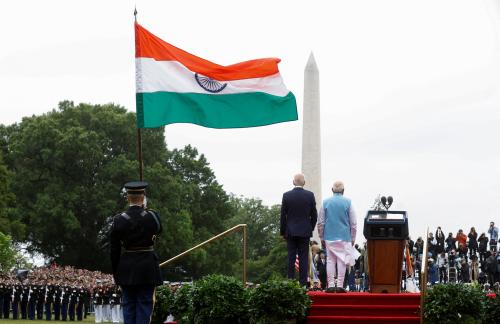In the first two weeks of December, Russian President Vladimir Putin made two quick trips to Turkey (December 1) and India (December 10 to 11) to sign a number of trade deals. As Clifford Gaddy and I underscore in the new expanded version of our 2013 book, Mr. Putin: Operative in the Kremlin (Brookings, February 2015), this is all part of a carefully crafted foreign policy agenda. Putin’s agenda also happens to mesh neatly with those of his counterparts in Turkey and India.
The agenda stems from Putin’s long-standing concerns about the Russian economy that pre-date Western sanctions on Moscow after Russia’s March 2014 annexation of Crimea. When Putin announced he would return to the Russian presidency in September 2011, Russia’s economy was already at risk. In the summer of 2011, his economic experts were full of bad news about spillover from the ongoing eurozone crisis. Putin concluded he would need to shift his economic policy to put less emphasis on growth and more on survival. Once he was back in the Kremlin, he moved to ensure that Russia (and his regime) could withstand economic shocks.
Putin encouraged the development of domestically-produced goods to replace imports, promoted large state-financed infrastructure and defense projects, and pushed for the creation of the Eurasian Economic Union to create a protectionist regional buffer around the Russian economy. He also set out to make sure he had plenty of economic alternatives outside Europe, in case his European trading partners continued on their downward spiral––or just in case Moscow’s relations with any of them soured. He perhaps did not anticipate, back in 2011-2012, that his push for the Eurasian Union would lead to a clash with the EU, a proxy war in Ukraine’s eastern regions, and an open rift with Russia’s most important European partner, Germany, but Vladimir Putin always plans for contingencies and keeps his options open.
Working Around Sanctions
U.S. and E.U. sanctions have inflicted considerable damage on the Russian economy in 2014, but they have not yet persuaded Putin to change course in Ukraine. In part this is because Putin is still betting he can work around the sanctions by associating with countries that want to dilute the political influence and economic leverage of the United States. Putin has long prioritized presidential visits and trade deals that revitalize old Soviet connections in Africa, Asia, Latin America, and the Middle East. Now he is nurturing relationships with leaders like Recep Tayyip Erdoǧan of Turkey and Narendra Modi of India who see themselves as major regional players.
In selecting countries and leaders to engage with, Putin is almost always guided by Russia’s economic interests––targeting states with industries that link to the production chains of key Russian economic sectors, or the home countries of international companies operating in Russia’s energy and manufacturing sectors that produce massive tax revenues and/or large numbers of Russian jobs. Putin has put particular emphasis on China and other members of the BRICS (Brazil, Russia, India, China and South Africa) grouping, who have common economic interests and a degree of antipathy toward the United States. Most importantly, from Putin’s perspective, Russia’s “fellow” BRICS are all outside the Euro-Atlantic system.
Putin’s efforts to embrace the BRICS paid off when Russia was axed from the G8 in March 2014 just after the annexation of Crimea. Putin was due to host the G8 meeting in Sochi to top off his successful Winter Olympics. When the G7 leaders decamped to Brussels instead, he countered their move by launching a six-day tour of Latin America after the BRICS summit and 2014 World Cup final in Brazil.
Targeting Turkey
Unlike India, Turkey is not a member of the BRICS. But it is an important regional player that considers itself independent, in spite of its links to European-Atlantic institutions. Ever the operative, Putin sees Turkey as a valuable asset in dealing with two of his main adversaries in the Ukraine standoff, NATO and the EU. In the case of NATO, Turkey’s value is clear. Turkey is a full member of NATO. Putin will have a “friend” inside the enemy camp. The EU connection is different. Despite years of waiting in the wings, Turkey has not been accepted into the EU, and it has grown more and more frustrated at its lack of progress. Turkey is already a headache for the EU. The country’s move towards Russia is not likely to make things better. If that happens, Putin—who is a master of tapping into others’ discontent and desires for alternatives—will be delighted.
Putin’s Turkish business deals send another important signal to Germany and EU countries that became significant trading partners with Russia in the 1990s and 2000s. Putin and Erdoǧan differ, very strongly, on how to deal with Assad and the civil war in Syria, and Turkey has its own historic equities in Crimea and Ukraine. But Putin put political differences and geopolitics aside in his trip to Turkey. His visit was all about business. Putin’s message to Europe was: disagreements don’t have to get in the way. It is possible to do business even if you are at odds on Syria, or Crimea and Ukraine!
Putin also surprised the EU, in Turkey, by jettisoning Russian energy giant Gazprom’s South Stream pipeline, which was planned to bring gas to Europe across the Black Sea and up through Bulgaria, Serbia, Hungary and Slovenia to Italy. This was done in the manner of a gambit in a chess game: Putin offered up a tactical sacrifice (South Stream) in order to avoid a strategic defeat (the potential loss of Russia’s dominant position in Europe’s gas market). South Stream had become too expensive financially and politically. Sanctions and falling energy prices were reducing Gazprom’s disposable cash and cutting off future loans; and Gazprom’s primary international commercial partner, the Italian energy company ENI, had balked at the idea of footing more of the bill. The EU was also blocking the pipeline construction in Bulgaria, and putting pressure on the other states to reconsider their participation. The game was up on South Stream, and in Putin’s view, it was better to make the tactical sacrifice, in spite of all the sunk costs, and look elsewhere for advantage.
In Turkey, Russia already has a gas export pipeline in place that can be expanded; and Turkey, itself, has aspirations to become a major energy trading hub between Europe and the Middle East. Turkey’s ambitions and existing infrastructure could eventually allow Putin to bring more Russian gas into Europe through the back door. Turkey’s gas transit corridor might not be as desirable for Putin as Russia’s own pipeline across the Black Sea, but it will get the job done.
The Turks are willing players in this particular game, and just like the Indians––who want to cut out middlemen in Europe and the Middle East to buy rough diamonds directly from Russia for India’s massive diamond cutting and polishing industry. Modi and Erdoǧan are not just pieces that Putin is moving around a geo-economic chess board. They have their own gambits to play.
Diamonds may not be forever, and their prices fluctuate just like those of oil and gas, but there is a great deal of mutual benefit for India and Turkey in creating their own commodity hubs based on Russian raw materials. With moves like this, with ready partners in different arenas, Putin intends and hopes to stay at least one step ahead of the West and U.S. and European sanctions in the ongoing struggle over Ukraine.



Commentary
Op-edPutin’s Turkish and Indian Gambits
December 12, 2014